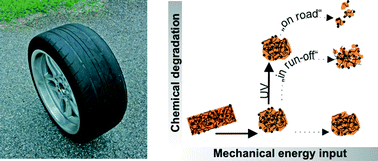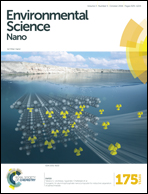Release from nanomaterials during their use phase: combined mechanical and chemical stresses applied to simple and multi-filler nanocomposites mimicking wear of nano-reinforced tires†
Abstract
Nanocomposite materials are ubiquitous in outdoor applications. Product performance is determined by the resilience of the bulk material, but aging induces nanoscale releases already from conventional materials. Thus, aging and wear (or wear and aging) might also release embedded nanomaterials from composites. Here, we challenge the hypothesis of release being induced by a synergy of stresses by varying both the sequence and intensity of chemical aging (UV, hydrolysis) and mechanical wear (sanding, shaking, sonication) degradation pathways. First, we explore the effect of varying the intensity of mechanical shear after aging on model elastomers with one of three nanofillers: carbon black is commercially used as a photoprotective filler, and thus serves as a negative control that should reduce release compared to the neat elastomer. In comparison, we find that carbon nanotubes suppress release even more strongly, whereas silica nanofillers increase release. Free nanofillers were occasionally observed with sonication shear after aging. We then reverse the sequence of stresses to explore the pathway of secondary environmental fragmentation using different intensities of UV/hydrolysis after mechanical fragmentation of novel car tires, represented by highly filled natural rubber with 40% carbon black and additionally 4% carbon nanotubes. We determined a maximum free nanofiller mass share of 0.045% of the aged tread wear mass. The “on the road” scenario releases more fragments from simulated tread wear than the “washed to surface water” scenario. Both case studies suggest that the importance of parameters controlling release phenomena overall decreases in the order: aging scenario–matrix properties–nanomaterial properties. Only synergistic aging stresses induce considerable releases.


 Please wait while we load your content...
Please wait while we load your content...